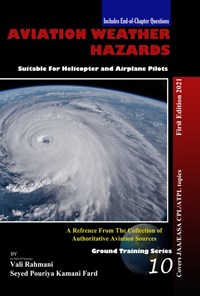
کتاب Aviation weather hazards 10
معرفی کتاب Aviation weather hazards 10
کتاب Aviation weather hazards 10 نوشتهٔ سیدپوریا کمانی فرد (مربی و خلبان آزمایشی هلیکوپتر) و ولی رحمانی است. انتشارات کنکاش این کتاب را روانهٔ بازار کرده است. این اثر موضوعات JAA/EASA CPL/ATPL را نیز بههمراه واژهنامهای برای دانشجویان خلبانی هلیکوپتر و هواپیما در بر گرفته است.
درباره کتاب Aviation weather hazards 10
کتاب Aviation weather hazards 10 با ویراستاری «علی اقلیمی» آماده و منتشر شده است.
این کتاب که تماماً به زبان انگلیسی است، در ۲۵ بخش نوشته شده است.
خواندن کتاب Aviation weather hazards 10 را به چه کسانی پیشنهاد میکنیم
خواندن این کتاب را به دانشجویانی که تحت آموزش هوانوردی ارتش هستند، پیشنهاد میکنیم.
بخشهایی از کتاب Aviation weather hazards 10
«Today, weather continues to be one of the most important factors affecting aviation safety and efficiency. During 1988- 1992, one-fourth of all aircraft accidents and one third of fatal accidents were related to weather (Salottolo, 1994). In addition, 41 percent of air traffic delay time during 1990 was attributable to weather. These delays accounted for approximately $4.1 billion of direct costs to the airline industry-not including the financial loss and inconvenience suffered by the traveling public (OFCM, 1992). Projected increases in air travel will tend to exacerbate the impact of adverse weather on aviation safety and efficiency Efficiently managing the research, development, acquisition, and operation of aviation weather systems and services is essential to accommodate increased air traffic while continuing to meet public expectations for safety, efficiency, affordability, and convenience.The skill and experience of pilots involved in aviation vary widely, as do the capabilities of their aircraft. Thus, the aviation weather system must provide a wide variety of services to accommodate the needs of individual pilots as well as those of the air traffic controllers, airline dispatchers, flight service specialists, aviation weather forecasters, and airport managers upon whom they depend. Assessing the effectiveness of existing aviation weather services and related research is a difficult task. Although many accidents are related to weather, the number and frequency of accidents are an imperfect and incomplete measure of effectiveness for two reasons. First , although many weather-related accidents could be reduced by improving the quality of preflight and en route aviation weather services, weather-related accidents also could be reduced by enhancing training programs to increase the effectiveness of decision making by pilots, controllers, and other users in the face of uncertain or adverse weather conditions. Second, adverse weather can create dangerous situations that, because of pilot skill, luck, or some other circumstance, do not result in aircraft accidents or reportable incidents, and these situations do not appear in accident statistics. Similarly, the efficiency of aviation operations is a product of many diverse factors, and it is difficult to isolate the specific impact of aviation weather services. Accordingly, accident prevention is a primary goal of the aviation weather system. This emphasis is reflected in the FAA strategic plan (FAA1994b), which includes two weather- related objectives: 1- Reduce the likelihood of weather-related accidents by improving access and delivery of weather information and by improving technology. 2- Reduce the capacity-impacting consequences of weather phenomena by improved weather forecasts and increased accuracy, resolution, and dissemination of observations on the ground and in the air. All of the above points explains the need for accurate meterological knowledge in Aviation.»
حجم
۱۲٫۵ مگابایت
سال انتشار
۱۴۰۱
تعداد صفحهها
۱۵۸ صفحه
حجم
۱۲٫۵ مگابایت
سال انتشار
۱۴۰۱
تعداد صفحهها
۱۵۸ صفحه